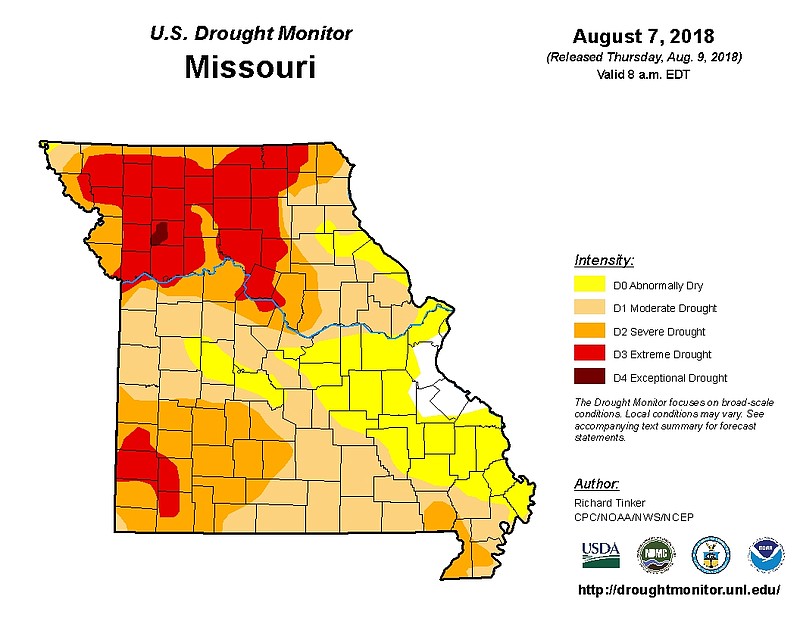Tuesday's rains did little to impact the drought conditions throughout Missouri, but new long-range forecasts offer a little hope for some relief.
At Wednesday's meeting of the Missouri Department of Natural Resources Drought Assessment Committee, National Weather Service Hydrologist Mark Fuchs told the committee the long-range outlook for the state from August through October now shows temperatures will be about average for that time of year as will precipitation.
"When we talked at the end of July we were looking at above average temperatures and below average precipitation so this is an improvement," he said.
Over the next week to 10 days the Lake of the Ozarks should see some chances for "significant" precipitation of around an inch or more, Fuchs added.
Despite this, most of the state is affected in some way by drought conditions. The worst is in northern Missouri where most counties from the Iowa border to near the I-70 corridor are now listed as in "extreme drought" according to the U.S. Drought Monitor. Three water systems in the northwest part of the state have adopted various conservation measures to try and get enough water to meet customer needs and as many as five to six more are looking at going to those in the very near future, according to DNR officials.
The latest drought map shows all of Boone County in "severe" drought along with the western side of Callaway County and the extreme northern parts of Cole and Moniteau counties.
"Moderate" drought is shown in most of Cole and Moniteau counties, as well as in central and eastern Callaway County.
Abnormally dry conditions are shown in southern Moniteau and Cole counties, all of Miller County and most of Osage County.
One of the recommendations that members of the committee did make Wednesday was to show communities how they can do simple conservation measures to avoid getting into desperate situations when a drought occurs. This could be as simple as having residents reduce daily water usage to making repairs to infrastructure. DNR officials said drought impacts can be mitigated if these steps are taken as early as possible.
While there have been measures taken by agencies such as the Missouri Department of Transportation offering a special overwidth hauling permit to help farmers and ranchers move hay as needed, don't expect any presidential disaster declaration for the drought we're dealing with.
Officials with the State Emergency Management Agency said no state has ever gotten that due to the difficulty in trying to meet the standard criteria for such a declaration, unlike what is needed to meet a declaration following a flood or tornado. It was also pointed out that there have been times in the past, and it's likely we'll see it again, where counties have gotten declarations from the Secretary of Agriculture when droughts have occurred, but those are not as broad in scope as a presidential declaration.
Gov. Mike Parson directed DNR to activate the committee and the associated drought-impact teams to help coordinate resources to address the impacts of this year's drought.
The assessment committee will meet over the next several weeks to see what steps need to be taken to address the drought, but some actions have already been taken.
In June, DNR's Soil and Water Districts Commission granted a statewide variance that allows grazing on land that normally would not have livestock on it in an effort to help farmers deal with the drought.
The USDA Natural Resources Conservation Service is assisting Missouri livestock producers affected by drought. Missouri has $2 million available to help farmers plant cover crops to address inadequate feed and forage and other natural resource concerns.
Farmers and ranchers in counties affected by drought can apply for assistance at local NRCS offices until Aug. 31. The U.S. Drought Monitor Report will be used to determine eligibility. Applications for assistance in counties with the more severe drought conditions will be given priority.
To keep up with information from the assessment committee and any other drought related matters, visit dnr.mo.gov./drought.

